The VM Zodiac as a pictorial cycle: a comparative analysis (by Marco Ponzi)
I’m pleased to present a wonderful, insightful and detailed piece of work, again by Marco Ponzi, concerning the Voynich Manuscript’s Zodiac pages. Thanks Marco.
Parallels for the Voynich Zodiac as an Image Cycle (by Marco Ponzi)
A few months ago, Johannes Klein proposed a quantitative analysis of the Voynich zodiac illustrations based on a set of “binary charactersâ€. This post describes the results of an attempt to put Johannes’ idea into practice. I would like to thank Darren Worley and Greta Zamparini who volunteered to proofread these notes and contributed with their helpful suggestions. I am also grateful to Stephen Bax for accepting to publish this post on his website.
131 different zodiac cycles have been compared. Many of the sources analyzed have been originally pointed out by Darren Worley. Works mentioned by a number of other Voynich researchers have also been included: Stephen Bax, David Jackson, Diane O’Donovan, J.K. Petersen, Rupert Rideec, Thomas Spande (on Nick Pelling’s blog), Ellie Velinska, Rene Zandbergen. The comparison is based on a largely ad-hoc set of boolean (true/false) features, including some of those originally proposed by Johannes, as well as some of those used on the Warburg Institute Iconographic Database (also mentioned by Johannes).
The objects that have been analyzed originate from places corresponding to 26 different modern nations: Afghanistan, Armenia, Austria, Belgium, Egypt, England, France, Georgia, Germany, Greece, India, Iran, Iraq, Ireland, Israel, Italy, Netherlands, Poland, Romania, Spain, Sweden, Switzerland, Tunisia, Turkey, Uzbekistan, Ukraine. The most represented nations are Italy (23 zodiac cycles), Iran (21), France (20), Germany (16, 4 of which Hebraic). Most of the objects are manuscripts, but other media have been compared, including: stone sculptures, stained glasses, metalworks, mosaics, pottery, coins, tapestries.
Many of the objects date to the XV (30%), XIII (25%) and XIV (15%) Centuries. The average dating is 1300 ca.
Binary Characters
The following 20 binary characters have been considered (those that appear on the Warburg site are marked with a *):
Pisces – Cord: Two fish are present and they are joined mouth-to-mouth by a cord.
Aries – Bush: A bush or small tree is present.
Aries – Grazing: The animal is grazing the plant.
Taurus – Manger: The bull is eating from a cylindrical manger (or drinking from a cylindrical well or bucket). This is the only feature for which no matching image has been found.
Gemini – Male and Female:* Two persons of opposite sexes.
Gemini – Dressed:* The two persons are dressed.
Gemini – Embracing: The two persons are represented in an affectionate pose (embracing or holding hands).
Cancer – Double: Two crustaceans appear in the image.
Cancer – Lobster: The crustacean looks like a lobster, not like a crab.
Leo – Tail: The tail of the animal is between its legs.
Leo – No Mane: The lion has no or very little mane.
Virgo – Not winged:* The person representing Virgo is not winged.
Virgo – Standing: The person stands.
Virgo – No scythe: The person is not using a scythe.
Virgo – Spica:* The person holds an object (the Warburg site lists different variants)
Libra – No person:* Only a pair of scales.
Scorpio – Four legs: The represented animal has 4 legs.
Scorpio – Tail loop: The tail of the animal forms a loop.
Sagittarius – Human:* The subject is a person, not a centaur nor a half-centaur or satyr 영광의 깃발 다운로드.
Sagittarius – Crossbow: The person holds a crossbow (instead of the typical bow).
The focus of this writing is limited to the iconography of the medallions, other important aspects of the Voynich zodiac cycle not discussed here include: the fact that the cycle begins with Pisces instead of the usual Aries or Aquarius; the meaning of the about 30 figures surrounding each sign; the fact that Aries and Taurus where apparently split into two separate pages.
All the zodiac cycles have been compared simply on the basis of the number of matching binary features. Features that for whatever reason could not be determined have been excluded from the matching percentage.
The Islamic tradition
An extensive and well illustrated discussion of Islamic astrological imageries can be found in Following the Stars, by Stefano Carboni, on the the Metropolitan Museum website.
A typical feature of Islamic cycles is that a personification of the planetary ruler is included in the image of each sign: so all signs include the image of one or more people. For instance, Aries is usually ridden by a warrior representing Mars. The same warrior appears in Scorpio, holding one or two scorpions.
One of the Islamic cycles that can be better compared with the Voynich zodiac (since it does not include the above mentioned personifications) is the Horoscope of Prince Iskandar, Iran, 1411. These are a few of the differences from the Voynich zodiac and similar European zodiacs:
-Pisces: the two fish are curved and form a circle;
-Gemini are represented as conjoined;
-Cancer is represented as a crab, not as a lobster;
-Virgo is represented as a kneeling man with a scythe;
-Scorpio is represented by an actual scorpion;
-Sagittarius is the classical centaur.
Many of the above features are shared by most Islamic zodiacs and actually make them more faithful to the classical tradition than Central European zodiacs of the middle ages. An exception to this is Virgo: “for some reason,
the name of the constellation, Al ‘Adhra (literally, “the
virgin”), was not passed on to the corresponding sign
of the Zodiac. Instead, the sign was named after the
brightest star of the constellation, sunbula, which means
‘ear [of corn]’. Consequently, when the astrological
iconography was codified, the image of the virgin, a
female figure, gave way to the representation of a male,
evidently the Planetary Lord Mercury, who was shown
as a farmer slashing ears of corn with a crescent-shaped
scythe. This image became standard and was included
in all zodiacal cycles, while the female figure of the
constellation of Virgo remained unchanged in astronomical treatises … The few exceptions to the rule that occurred
later were probably influenced by European traditions†(Carboni).
The Voynich zodiac does not seem to conform to the typical iconography of Islamic zodiacs, but a few characters deviate from the European standard in a direction that could suggest an Eastern / Islamic influence, in particular the goat-like aspect of Aries (image from the Metropolitan Museum, engraved brass basin, Egypt or Syria, 1300 ca) and the figure of Leo (Walters Museum 54523, brass bucket, Iran, XII Century). However important and interesting those details, they can at most suggest a possible Eastern influence: the iconography of most of the signs is European.
The Ashkenazi tradition
Since apparently the Voynich manuscript was produced in Central Europe or France but does not seem to be written in a European language, Hebrew works from Germany and nearby areas (a region called “Ashkenaz†in the European Hebraic tradition) provide a relevant parallel. Ashkenazi Mahzorim (prayer books for the High Holidays) often include illustrations of the zodiac cycle. Most of the informations presented in this paragraph derive from this web page by the Israel Museum of Jerusalem and The Mahzor as a Cosmological Calendar: The Zodiac Signs in Medieval Ashkenazi Context by Sarit Shalev-Eyni.
Ashkenazi zodiacs were amply influenced by the European iconographic tradition, so much so that “Torah binders made in honor of boys born in Nisan [correspondig to Aries] sometimes feature a lamb holding a banner. This image is evidently taken from a Christian model in which the Lamb of God holds a flag with a cross†[Israel Museum].
“The set of medallions in the decoration program of the Ashkenazi mahzor was based on Latin calendars in Christian ritual books such as psalters, breviaries, and Books of Hours 펌프잇업 prex3 다운로드. These books usually open with a liturgical calendar containing a list of the Temporale feasts and the Days of the Saints (Sanctorale) in a cycle of twelve units representing the months and accompanied by a double system of medallions containing the zodiac signs and the labors of the months. The illustrators of the Ashkenazi mahzorim adopted the plan of the calendar with the zodiac signs and sometime also included another set of the labors of the months, which further stressed their origin in the Christian books. The affinity to the Christian medallions is also apparent in the iconographic design of some of the zodiac signs, such as the Lamb, the first zodiac sign in the Hebrew cycle, which is designed as a ram with round horns typical of the sign of Aries, or Virgo, that is depicted with a fleur de lis (or another flower), alluding to the Virgin Mary, as was common in Christian calendars†[Sarit Shalev-Eyni].
It seems likely that the author of the Voynich zodiac did something similar: he copied the zodiac sequence from a European manuscript to illustrate a text of non-European content and language.
While Ashkenazi zodiacs assimilated much of European iconography, they usually present features that make them recognizable as Hebrew and that never or very rarely appear in Christian calendars. For instance:
– Pisces illustrations include three or four fish instead of the usual two.
– Aries has no horns (it is a lamb, not an adult animal).
– Gemini are represented with the heads of animals, to avoid depicting the human form. They sometimes hold a stick (a symbol of the head of the eclipse dragon, commonly found in Islamic zodiacs). In other cases, two men wearing the discriminatory headgear imposed on Jews are portrayed.
– Cancer is depicted as a hybrid monster (Sarit Shalev-Eyni: “the phonetic similarity between Satan and Sartan -the Hebrew word for Crab- in this context probably contributed to the association between the twoâ€).
– Libra illustrations include the hand of God, emerging from a cloud to grasp the scales.
– Sagittarius takes the form of a solitary bow, with neither person nor centaur. Sometimes only the arms and hands of the archer are represented.
As can be seen from the above list, Ashkenazi zodiacs often considerably deviate from Christian zodiacs, but mostly in different directions from the anomalies present in the Voynich zodiac. For instance the Oppenheim Mahzor zodiac wheel features a lobster as Scorpio, a monster as Cancer, Sagittarius without an archer. Gemini, Aries and Pisces also differ from typical European illustrations.
Sometimes a Mahzor cycle contains only minor variations from the Central European tradition and the illustrations are not easily recognizable as related to a different culture. In these cases, the illustrations are closer to the Voynich cycle: Dresden ms A46a matches half of the binary characters and is one of the best twenty matches.
In analogy with the Ashkenazy tradition, the amount of deviation observed in the Voynich zodiac could well be explained as the interaction of two different cultures, one of which is the tradition of Central Europe or France. The present study cannot suggest any specific candidate for the second culture involved in the production of these images.
Best matching Zodiac Cycles
A. Heidelberg, ms Cod. Pal. Germ. 298, Bavaria, Germany, first half of the XV Century (70% match)
This manuscript from South Germany was found by Darren Worley, following a post by Ellie Velinska discussing a similar manuscript Adobe cc free download. Cod. Pal. Germ. 298 comprises a number of different texts from different dates, the zodiac signs appear in the fourth section, written in German. The description of the manuscript calls this section “Tierkreiszeichenlehreâ€, i.e. “an essay about the Zodiac signsâ€.
B. Graz MS 286, Seckau, Austria, 1160-1170 (65% match)
A Latin breviary written in Seckau, near Graz. The zodiac medallions are drawn in brown and red ink and are not painted. They illustrate the twelve pages of the calendar in the initial pages. It is noteworthy that many of the elements that occur in the Voynich zodiac were already present in Central Europe cycles during the XII Century.
C. Soissons Stained glass window, France, XII-XIII Century (60% match)
This work has been repeatedly mentioned by Diane O’Donovan with reference to Voynich f73v (for instance here).
The zodiac stained glass window now in Soissons likely comes from the nearby town of Braine. It was moved to Soissons, reassembled and heavily restored in the XIX Century. The main area is occupied by the large figures of four ancestors of Christ. The figures are surrounded by twenty eight medallions, including the twelve signs of the zodiac. More details can be found in this French document.
D. Strasbourg Cathedral reliefs, Alsace, France, 1280 ca (60% match)
The right portal of the facade of the Strasbourg Cathedral is flanked by twelve statues illustrating the Parable of the Wise and Foolish Virgins. The bases of the statues are decorated with reliefs depicting the signs of the zodiac and the labors of the months. Strasbourg is the capital of Alsace, a historically German-speaking region.

Other works mentioned below
In addition to the best matching sources, some comparisons from other sources that provide interesting parallels for specific signs are proposed. Here those that are more frequently mentioned are listed (more are discussed with reference to specific zodiac signs).
* Österreichische Nationalbibliothek cod. 1842, Wroclaw, Poland, 1400 ca (80% match?)
This work is discussed in the Crossbow Sagittarius page. The manuscript is a Book of Hours (Horae canonicae in Polonia Scriptae) and the zodiac illustrations appear in the context of a calendar. Since it was impossible to find images for most of the signs, the matching percentage is not as reliable as those of other works.
* St. Gallen, Stiftsbibliothek, Cod. Sang. 402: Roman Breviary, Switzerland, XIV Century (53% match)
From the description at “e-codices.unifr.châ€: “Book of hours, composed for an unknown convent in the diocese of Basel: excellent example of early Gothic book art Security Onion. With a Calendar, 14 miniatures of the life of Christ and Mary, the Psalter, Canticles and an All Saints’ Litanyâ€. The manuscript is written in Latin.
* Pierpont Morgan Library M 700, Du Bois hours, Oxford?, England, 1325-1330 ca (47% match)
This 1330 ca English manuscript is discussed by Olga Koseleff Gordon in her paper Two Unusual Calendar Cycles of the Fourteenth Century. In that paper, the Zodiacal cycle is compared with a similar, less anomalous, one (MS M.511, from Bologna, also at the Pierpont Morgan). The greatest deviations from standard cycles in ms M.700 are: Aries (two goats instead of a ram); Taurus (entirely missing); Cancer (two crabs); the insertion between Libra and Scorpio of an image representing three goats (Capricorn is also included in the cycle in its usual position and form). The manuscript is written in Latin.
* Biblioteca Apostolica Vaticana, Pal, lat. 1369, South Germany (45% match)
This 1444 manuscript has been pointed out in 1996 by Rene Zandbergen as a relevant parallel for the Voynich zodiac.
It is also discussed here. Darren Worley writes that it contains a collection of different Arabic astrological texts translated into Latin. The zodiac signs appear in round medallions in seven pages devoted to the domiciles and detriments of the planets. The drawings are sketched in ink outline, lightly colored, with no gilding: the overall visual effect is close to that of the Voynich ms.
* St-Lazare church reliefs, Avallon, Burgundy, XII Century (44% match)
These stone reliefs appear, together with illustrations of the Labors of the Months, in the third archivolt above the central portal of the church. Their state of conservation in rather poor, yet most of the signs are still recognizable in some detail. This zodiac cycle has been mentioned by user Don of Tallahassee on www.voynich.ninja.
* Berlin Staatsbibliothek, Regimen Sanitatis Ms. germ. Fol. 1191, Alsace (probably Strasbourg), France, 1450-1460 (42% match)
From the website description: “Heinrich von Laufenberg (circa 1390–1460) was a cleric from the southwest German town of Freiburg. … His Regimen Sanitatis (Regimen of health) of 1429 is a medical-astronomical compendium of guidance to healthful living that stretches to more than 6,000 lines of metrical German. The work presents the reader with practical rules for healthy living concerning such matters as a balanced diet, phlebotomy (bloodletting, then a common treatment to prevent or cure illness), and ways to prevent the plague. The text reflects the contemporary scientific view that planetary configurations affect an individual’s well-beingâ€.
The manuscript is written in German and was produced in Alsace. Zodiac signs appear in two distinct sequences, the first of the two is closer to the Voynich zodiac cycle, but Gemini, Virgo and Libra are missing.
This work was pointed out by Darren Worley because of the presence of a Crossbow Sagittarius, so it provides an example of a Crossbow Sagittarius from a region that is now part of France. Another interesting feature of the illustrations is that one or two stars, suggestive of the origin of the zodiac signs as constellations, appear in some of the illustrations; their position is largely consistent with that of similar stars in the Voynic zodiac.
* BNF ms LAT 7351 Liber Albandini, XIV Century (40% match)
The relevance of this work for the Voynic zodiac has been pointed out by Ellie Velinska here Praise free download.
The Liber Albandini is a Latin divination essay. The zodiac signs are depicted in full page illustrations starting with Aries on f37r. The manuscript was written in the XIV Century. The BNF site does not seem to provide any clear information about the place of origin but an unnumbered page at the end of the manuscript contains a long annotation in French in an ancient hand: I assume the manuscript was produced in France.
DISCUSSION OF THE SINGLE ZODIAC SIGNS
Pisces
It is anomalous that a zodiac cycle begins with Pisces. Aries is the standard astrological beginning of the zodiac cycle. In the context of a calendar, the first sign is usually Aquarius, corresponding to January. While the position of Pisces in the Voynich Zodiac is difficult to explain, the iconography of the sign is rather conventional, but for “the knotâ€: the two fish are connected mouth-to-mouth by a cord. In the middle of the cord there is a star, which apparently corresponds to the prominent star Alrisha (“the knotâ€). The image is at variance with other examples which represent a mouth to mouth cord, but without the knot. In the Voynich image, the cord has been twisted, placing the “knot†at the top of the two fish, likely in order to make room for the large star and its Voynichese label. The “knot†usually appears in illustrations of the Pisces constellation, not of the zodiac sign. In the Pisces constellation, the cord connects the Pisces tail to tail and the two fish do not face in opposite directions, so the Voynich image does not wholly correspond to that tradition either. Possibly, the overall best match among the images presented below is the Soissons stained glass window. Graz ms 286 presents the smiling expression of the fish that was noted by Stolfi and Zandbergen in their EVA transcription of the Voynich manuscript, but the Graz illustration does not include the cord joining the two fish. The Berlin Regimen Sanitatis includes two stars positioned similarly to those in the Voynich ms, but none of the two is connected with the cord.
Aries
The fact that in the Voynich Zodiac Aries is represented as a goat and not as the usual ram has been widely discussed (see for instance this 2004 post by Jorge Stolfi). I was unable to find any satisfying parallel for the shape of the animal. Possibly, from this point of view, the most interesting one is the highly anomalous ms Morgan M.700. Aries from BnF ms Latin 7028 (Italy, XI Century) is also somehow goat-like and curiously its horns are decorated by a pattern of dots similar to that appearing in the Voynich ms.
It has also been noted that the Aries “goat†seems to be grazing. Mary D’Imperio wrote: “An amusing matter for special note is the fact that the animal in each case [Aries and Taurus] is enjoying a meal: Aries is dining with evident relish on the leaves of a small shrub, and Taurus is applying himself with equal determination to the contents of a sort of manger or feedbox carefully and realistically placed at his disposal. These details, in my view, support a horticultural, medical, or agricultural context rather than a magical or mystical one (although this can be only an impression)â€.
Ewa Sniezynska-Stolot
: “The genre scenes, eg. Aries eating a bush, suggest that the signs were redrawn from a calendarâ€.
Aries eating a bush is not uncommon; a possible explanation for this iconography is its derivation from illustrations of the Sacrifice of Isaac and the “ram caught in a thicket by his horns†(Genesis, 22). European zodiac cycles provide several examples of grazing Aries, including some of the best matching sources presented in the following image.
This biblical influence could appear also in some Hebraic sources, but I have been unable to find any examples 카앤유 다운로드. Usually, in the Hebrew tradition, the zodiac sign is represented as a lamb, without the prominent horns that appear in the European tradition.
Taurus
The bull seems to be eating from a cylindrical manger, or drinking from a cylindrical well or bucket. It has been impossible to find any parallel for this detail. I think this point deserves further investigation. Ewa Sniezynska-Stolot commented: “From the astrological iconography point of view, the Taurus at a well is somewhat strange – unless an image of donkeys was a basis for it and then it would refer to Cancer – but that is certainly going too far†(she seems to be thinking of the Praesepe -the Manger- and Aselli -the donkeys- asterisms).
Images of Taurus grazing a bush (similarly to Aries) are the closest analogues I could collect: in zodiac cycles, these images often come coupled for both signs.
Another somehow similar image is the Capricorn / Aquarius conflation that appears in Hebraic Mahzorim from Germany. In the Hebraic tradition, Aquarius is often represented as a well and/or a bucket. In this typology, Capricorn is depicted as a goat drinking from the bucket.
Gemini
Stephen recently published a page in which Darren Worley presents various excellent parallels for this image. Please refer to that page for a discussion of this sign. The present quantitative analysis considers three distinct features for Gemini: the two people should be 1) dressed, 2) of different sexes, 3) embracing or holding hands. Of the best matching sources, the only one displaying all these three characters is Wien Cod. 1842 (Horae canonicae in Polonia Scriptae, Poland, 1400 ca).
Cancer
While the classical image of Cancer is a Crab, the variant that represents the sign as a Lobster or Crayfish is common in all Europe: it occurs in about 40% of the examined sources, never in non-European sources. On the other hand, the duplication of the sign of cancer is extremely rare. The better example is the English ms Morgan M.700. Ellie Velinska recently pointed out a manuscript presenting another example (BNF Lat 7352) in which Cancer appears twice, once as a lobster and once as a crab. It is interesting that, in the Voynich manuscript, the two lobsters are joined by a cord identical to that appearing in most illustrations of Pisces. Duplication aside, some of the parallels considered provide good matches for the general shape of the crustaceans (the bifurcation of the lesser limbs, the three “beaks†in front of the head, the two specular semi-elliptical lines on the back).
Leo
A mane-less or almost mane-less lion appears in some European as well as non-European zodiac cycles. It has been suggested that Europeans images of this zodiac sign were sometimes inspired by cats (“Time in the Medieval World: Occupations of the Months and Signs of the Zodiac in the Index of Christian Art”, Colum Hourihane), since lions were not readily available to be used as models. According to Carboni, in Islamic art, Leo “is depicted in profile, looking either right or left, in a walking posture or with one
foreleg raised in a heraldic stance. Its image tends to be
that of a powerful, strong-bodied feline, with a large
head, slightly open, menacing mouth, and a very long
tail that curves around the hind legsâ€. This iconography is not exclusive to Islamic art and is also frequent in European art. Cod. Sang. 402 (Basel, Switzerland, XIV Century) provides a good parallel for the shape and posture of the animal 일리아드 다운로드.
The prominent triangular tongue of the lion is an uncommon detail worthy of further investigation (see for instance the above mentioned Persian bucket at the Walters museum).
Virgo
The form in which Virgo is portrayed is very common: a standing woman holding an object (a star or flower, in this case) representing Spica, one of the brightest stars in the zodiac. Most classical sources present the figure as winged. As discussed above, in Islamic images, a person holding a scythe is usually represented. A common variant in medieval Central Europe represents the figure as sitting. Many good parallels for the Voynich image can be found. What varies the most is the kind of object representing Spica (an ear of wheat being the most common). A figure holding an object in each hand is also rather frequent. The woman represented in the illustrations often wears a crown or a garland. I saw no examples in which she wears a chaperone as in the Voynich illustration. The Strasbourg relief and Cod Pal Germ 298 are good parallels, but in the Strasbourg relief the object representing Spica was partly destroyed, and in the German Manuscript the woman holds a garland. In the Graz manuscript, the woman is not holding any object. In the images from Soissons and from the Polish Horae Cod. 1842 the woman is sitting.
Libra
The categories defined on the Warburg database make clear that the most significant variant in images of Libra is the absence or presence of a human figure holding the scales. The two variants seem to have coexisted in most regions of Europe. Of the best matching sources, the Polish Horae is the only one in which a person appears.
Scorpio
The representation of Scorpio as a reptile or a fantastic animal is typical of Europe, with the exclusion of the Mediterranean regions (the only exception I am aware of is a mosaic in the Norman cathedral of Otranto in Apulia). Ellie Velinska and Darren Worley have recently posted a number of interesting parallels for the Voynich Scorpio (see here and here) including BNF ms Latin 7351, Liber Albandini, France, 1300-1399.
User Don of Tallahassee has posted an excellent collection of lizard-like Scorpio images on www.voynich.ninja: the collection includes the Avallon relief, possibly the best match I have seen so far. J.K.Petersen has published a late but interesting French example (Morgan Book of Hours, MS G.1, Loire, France, 1475 ca). Some of the best matching sources from German speaking areas have similar four-legged animals (in particular Pal Germ 298 and the Graz manuscript) but the French sources seem to display a more consistent tradition in this case, with “lizards†represented in profile. Don has noted that parallels also appear in England (e.g. the Canterbury Cathedral floor roundel, XIII Century). The star that in the Voynich Scorpio is placed above the animal, linked to its mouth by a long “tailâ€, is the most peculiar feature of the illustration. The Berlin Regimen Sanitatis provides an interesting parallel: a single star in front of the mouth of the animal (see also Pisces above).
Sagittarius
Sagittarius is usually represented by a centaur gp5. The fully human Sagittarius seems to be absent from late medieval cycles produced in Southern Europe: the exceptions to this are derived from Northern sources (such as Mantova ms Lat.209, De Sphaera, Lombardy, 1470 ca, copied from Children of the Planets woodblocks produced in Basel in 1430 ca).
The Crossbow in Sagittarius images has been observed only in works from German-speaking areas.
For further discussion of Sagittarius, please refer to this page. J.K.Petersen also discussed some of the images we presented, adding an interesting collection of images of fully human Sagittarii with a normal bow.
Conclusions
All the best matching cycles (see list below) originate from Germany, France, Austria, Switzerland and (possibly) Poland, with dates ranging from 1160 to 1450 ca. This evidence suggests that the Voynich zodiac cycle was copied from a source that was produced in Central Europe or in France, or by someone who was deeply familiar with works from that area. On the other hand, it is very unlikely that the Voynich zodiac medallions derive from an Italian or Spanish work (in particular, Scorpio and Sagittarius are represented differently in all Southern examples). It seems almost impossible that the Voynich cycle could derive from an Arabic or Persian zodiac.
The Voynich zodiac can be seen as anomalous, because it contains a number of uncommon features, but almost all of those features appear in other medieval European works. Some of the anomalies could be explained as traces of an Eastern influence. It should also be noted that, even if astrological images usually followed a well established tradition, deviations as wide as those in the Voynic zodiac are known (for instance the above mentioned 1325 ca English ms Morgan M.700, discussed in Two Unusual Calendar Cycles of the Fourteenth Century by Olga Koseleff Gordon).
Zodiac signs that can seem extremely deviant at first glance (e.g. the lizard-like Scorpio) actually fit into a well documented European tradition. A recurring element that is typical of the Voynich zodiac and for which it was not possible to find a consistent parallel is the presence of large stars linked by curved lines (“tails†in Stolfi and Zandbergen’s terminology) to the main subject of the medallion. Such stars appear in Pisces, Virgo and Scorpio. Some zodiac cycles (e.g. Bodley Mahzor Opp. 161; Berlin Ms. germ. Fol. 1191 Regimen Sanitatis; British Library ms Harley 7182) include one or two stars for each sign, possibly with the intention of marking the figures as having an astronomical/astrological meaning, but none of the examined sources presents stars with “tailsâ€.
Further research
Here are a few ideas for possible further research about the Voynich zodiac:
* There must be other zodiac cycles that could provide better matches than those presented here. Possibly, a 100% match does not exist, but 80 or 90% matches could likely be found somewhere.
* The stars with tails are the most prominent and systematic deviation of the Voynich zodiac from all the inspected cycles. Sources with similar stars would be particularly valuable.
* Parallels for the cylindrical well or manger next to the bull in Taurus would be of the greatest interest. It could also be useful to find examples for other details (e.g. the tongue of the lion) and zodiac cycles matching the costumes of the human figures: Gemini, Virgo and Sagittarius hamachi 다운로드.
* Further research on English sources could provide better matches for that region. It is a geographic area that has not been investigated in depth.
* If the “grazing Aries†actually originates from the biblical story of the Binding of Isaac, it should be possible to find examples of this iconography also in Jewish works.
* It would be interesting to examine the complete zodiac cycle from ms Oesterreichische Nationalbibliothek, Wien, cod. 1842 “Horae canonicae in Polonia Scriptae†(I have been able to find images for only five of the signs).
Sources
Below is the complete list of the analyzed sources, with the corresponding percentage match with the Voynic zodiac. Links to on-line digital images and a few additional notes are provided in this Google spreadsheet.
Oesterreichische Nationalbibliothek cod. 1842, Breslau (Wroclaw), Poland, 1385-1405 [80%]
Heidelberg, ms Cod. Pal. Germ. 298, Bavaria, Germany, 1400-1450 [70%]
Graz MS 286, Seckau, Austria, 1160-1170 [65%]
Soissons Cathedral stained glass, Northern France, 1200 ca [60%]
Strasbourg Cathedral reliefs, Alsace, France, 1280 ca [60%]
Heidelberg, Cod. Pal. germ. 148, Biblia pauperum, S. Germany, 1430-1450 [55%]
Morgan MS M.280, Augsburg, Germany, 1235-1250 ca [55%]
Morgan, MS G.73, Psalter, Franconia, Germany, 1250 ca [55%]
Cod. Bodmer 30, South Germany, 1200 ca [53%]
Cod. Sang. 402, Basel, Switzerland, 1300-1399 [53%]
Deutscher Kalender, 2° Cod. ms. 578, S. Germany, 1474-5 [53%]
Cod. Pal. germ. 148, Bayern, Germany, 1430-1450 [50%]
Mahzor – ms Dresden A.46.a, South Germany, 1290 [50%]
Ms BSB Cgm 7269, Konstanz, Switzerland, 1463 [50%]
Notre Dame de Paris, Portal of the Virgin reliefs, France, 1210-1229 [50%]
Notre Dame de Paris, West Rose Window stained glass, France, 1220 ca [50%]
Thurgau ms Y 24, Burgundian Breviary, France, 1400 ca [50%]
Walters Manuscript W.37, Book of Hours, Liege, Belgium, 1300-1310 [50%]
Mahzor Hungarian Academy of Sciences MS A 384, S. Germany, 1320 ca [47%]
Klau Library, sefer evronot [906], Germany, 1664 [47%]
Lund Astronomical Clock, Lund, Sweden, 1424 ca [47%]
Madrid INC 2729 (printed), Spain, 1492 [47%]
Morgan MS M.700, Book of Hours, Oxford?, England, 1325-1330 ca [47%]
Astrol. Sammelhandschrift (Cod. 5327 Han), S.Germany, 1469? [45%]
Rome, BAV, ms Pal lat. 1369, Astrological miscellany, S. Germany, 1444 [45%]
Tres Riches Heures du Duc de Berry, France, 1412-16 [45%]
Wellcome Library, London, MS 49, Apocalypse, Germany, 1420-1430 [45%]
Sagra di San Michele, portal reliefs, Piedmont, Italy, 1100-1199 [45%]
Sefer Evronot MS 2540, Central Europe, 1631 [44%]
Trinity Chapel floor medallions, Canterbury, England, 1200-1299 [44%]
Eglise St-Lazare reliefs, Avallon, Burgundy, France, 1100-1199 [44%]
National Library of Medicine ms 9409277, Wonders of creation, Iran, 1537-1538 [43%]
Mantova ms Lat.209, De Sphaera, Lombardy, Italy, 1470 ca [42%]
Berlin Staatsbibliothek, Regimen Sanitatis Ms. germ. fol. 1191, Alsace, France, 1450-1460 [42%]
Amiens Cathedral reliefs, Picardie, France, 1250 ca [40%]
Bibliothèque de Rennes Métropole MS 1834, Bretagne, France, 1400-1450 [40%]
BNF ms Latin 7351, Liber Albandini, France, 1300-1399 [40%]
Cambridge ms D 6, MRJ 81, England, 1250 ca [40%]
Iatromathematisches Hausbuch, Pal.Germ 291, Bavaria, Germany, 1477 [40%]
Madrid Ms 9267, Ludovici de Angulo De figura, Spain?, 1456 [40%]
Missal, Getty Ms 34, Bologna, Italy, 1389-1404 [40%]
Morgan Lib Ms M 103, Psalter, England, 1250 ca [40%]
Rothschild Mahzor, JTS MS 8892 f5r, Florence, Italy, 1490 [40%]
Morgan Book of Hours, MS G.1, Loire, France, 1475 ca [40%]
British Library, ms Arundel 60, Winchester, S. England, 1073 ca [40%]
Museum of the History of Science, Astrolabeby Abd al-Karim, Egypt, 1227-1228 [38%]
Morgan Library MS M.756, Cuerden psalter, Oxford, England, 1270 ca [37%]
Otranto Cathedral mosaics, Southern Italy, 1163-1165 [37%]
Fernando Gallego, ceiling of the Salamanca Library, Spain, 1486 ca [36%]
Met Museum, Brass Inkwell, Iran, 1200-1250 [36%]
Wooden Ceiling, Chodorow Synagogue, western Ukraine, 1651 [36%]
BnF, ms Latin 7028, f.54, Italy, 1000-1099 [35%]
British Library, ms Arundel 251, Germany, 1400-1499 [35%]
Mantua Astronomical Clock, Mantua, Italy, 1473 [35%]
Metropolitan Museum, Al-Sufi ms Rogers Fund, 1913, Iran, 1450-1499 [35%]
Ms. Rh. 172, Aurora Consurgens, St. Gall, Switzerland, 1450 ca [35%]
Padua Salone fescos, Veneto, Italy, 1425-40 [35%]
Pierpont Morgan Library, MS M. 511, Calendar, Bologna, Italy, 1324-1328 [35%]
Pierpont Morgan Library, MS M. 75, Breviary, Paris, France, 1350 ca [35%]
S.Miniato marble floor, Florence, Italy, 1207 [35%]
Horae BNF NAL 3191, Poitiers, France, 1455-1460 [33%]
Rabano Mauro, De Universo manuscript, Montecassino, Italy, 1022-1035 [33%]
Tempio Malatestiano reliefs, N. Italy, 1449-57 [33%]
Trivulzio Tapestries, Lombardy, Italy, 1503-9 [33%]
BNF ms Francais 9140, de proprietatibus rerum, Ahun, France, 1480 [33%]
Astrological Manuscript, Georgia, 1200 ca [32%]
Beit Alpha Synagogue mosaic, Israel, 500-599 [32%]
Bodleian Library, Opp.161, Mahzor, Germany, 1342 [32%]
British Museum, silver pen-box 1891,0623.5, Iran, 1281 [32%]
Morgan Library, Almanac and calendar, MS M.941, England, 1433 [32%]
Basel F.III 15a, De Rerum Natura, Ireland, 800 ca [30%]
BNF Arabe 2583, Kitâb al-Mawalid, Egypt, 1480 ca [30%]
BnF ms FR 135, France, 1400-1499 [30%]
BNF ms Gr Cheat engine download. 2243, Dynameron, Greece, 1339 [30%]
Cod. Sang. 827, Lake Constance, Switzerland, 1425ca [30%]
Morgan Lib MS M.785, Abu Ma’shar, Bruges, Belgium, 1402 ca [30%]
OS 1033, wood engravings, Basel, Switzerland, 1430 [30%]
Paris BNF, ms Latin 7330, Georgius Zothorus,Sicily, Italy, 1230 ca [30%]
Royal 19 C.I, South. France, 1300-1325 [30%]
Glasgow Univ. Lib. MS Hunter 229, Hunterain Psalter, England, 1170 ca [30%]
Circular seal with a zodiac, Afghanistan, 1150 ca [29%]
Metropolitan Museum, Stonepaste Bowl, Kashan, Iran, 1200-1299 [28%]
San Isidoro reliefs, Northern Spain, 1000-1099 [28%]
Metropolitan Museum, engraved brass basin, Egypt or Syria, 1300 ca [28%]
Montecassino Cod. 132, Rabanus Maurus, De Rerum Naturis, S. Italy, 1032 [28%]
Walters Museum 54523, brass bucket, Iran, 1100-1199 [27%]
BNF 2754, “”Catalan Atlas””, Northern Spain, 1375 [26%]
Dodechedron, BNF Fr 14771, Southern France, 1301-1400 [26%]
Horoscope of Prince Iskandar, Iran, 1411 [26%]
Leiden Aratea, Lorraine, France, 830-840 [26%]
MS. Bodl. Or. 133, Arabic, Iraq, 1390-1450 [26%]
Albumazar, British Library MS Sloane 3983, Netherlands, 1325-1375 [25%]
Ashmolean Museum, Jar with epigraphic band, EA1956.58, Iran, 1200-1250 [25%]
BNF ms Arabe 5036, Al-Sufi, Samarqand, Uzbekistan, 1430-1440 [25%]
British Museum, brass pen-box 1884,0704.85, Mosul, Iraq, 1230-1250 [25%]
Bronze Mirror, Louvre Museum, Seljuq, Iran, 1100-1199 [25%]
Chhatrapati Shivaji Maharaj Vastu Sangrahalaya, Akbar Shield, India, 1581 [25%]
Metropolitan Museum, brass Ewer base, 91.1.530, Iran, 1200-1250 [25%]
Michael of Rhodes, Venice, Italy, 1434 [25%]
Pierpont Morgan Library, MS. G.14, Book of Hours, Italy, 1475 [25%]
Topkapi Sarayi Muzesi. Manuscript. H1703, Turkey, 1600 ca [25%]
Vaso Vescovali, Herat, Iran, 1200 ca [25%]
Walters Ms. W.593, Wonders of creation, Turkey, 1500-1599 [25%]
BNF ms Latin 7331, georgius zothorus, liber astrologiae, France, 1450 ca [25%]
Walters Museum 54.453, brass vase, Khorasan, Iran, 1200 ca [25%]
Louvre Museum, metal ewer OA 5548, Iran, 1200 ca [23%]
Fountain reliefs, Perugia, Central Italy, 1275-8 [22%]
British Library, ms Harley 7182, Ptolemy cartography, Florence, Italy, 1450-1475 [22%]
Brooklyn Museum, Copper Jug (Mashraba), Khurasan, Iran, 1200 ca [21%]
Aion Mosaic, Sentinum, Central Italy, 200-250 [21%]
Berlin Zodiac Dish, Iran, 1563 [20%]
Matenadaran MS 3884, Armenia, 1461-1478 [20%]
Met Museum, Rogers Fund, Jajarmi ms, Isfahan, Iran, 1340 [20%]
Phanes Greco-Roman relief, Rome?, Italy, 100-200 [20%]
BAV Reg.lat.1283, Astromagia, Castile, Spain, 1276-84 [18%]
Svetitskhoveli Cathedral frescos, Georgia, 1300-1700 [16%]
The Brooklin Museum, Divination Bowl, Iran, 1550 ca [16%]
Vat. gr. 1291, Byzantine Ptolemy’s Handy Tables, Turkey, 820 ca [16%]
Alfonso X – Lapidario, Castile, Spain, 1270 ca [15%]
Met Museum 91.1.604, Brass inlaid tray, Egypt, 1300 ca [14%]
Sotheby’s, brass jug, Mosul, Iraq, 1200-1250 [14%]
Metropolitan Museum, Brass Ewer, 44.15, Khurasan, Iran, 1180-1210 [13%]
Probota Monastery, fresco, Romania, 1532 [13%]
Victoria & Albert Museum, divination bowl 779-1889, Iran, 1500-1599 [13%]
Wellcome Library, MS Persian 373, Iran, 1700 ca [13%]
Met Museum, Flask, Kashan, Iran, 1300-1350 [11%]
BNF Latin 7272, Naples, Italy, 1325-1330 [11%]
Padua Baptistry frescos, Veneto, Italy, 1375 [11%]
Jahangir coins, India, 1618-1625 [8%]
Voronet Monastery, fresco, Romania, 1547 [7%]
Bardo Museum Roman Mosaic, Zaghouan, Tunisia, 200-299 [0%]
- Posted in: Voynich ♦ Voynich cosmology ♦ Voynich Zodiac
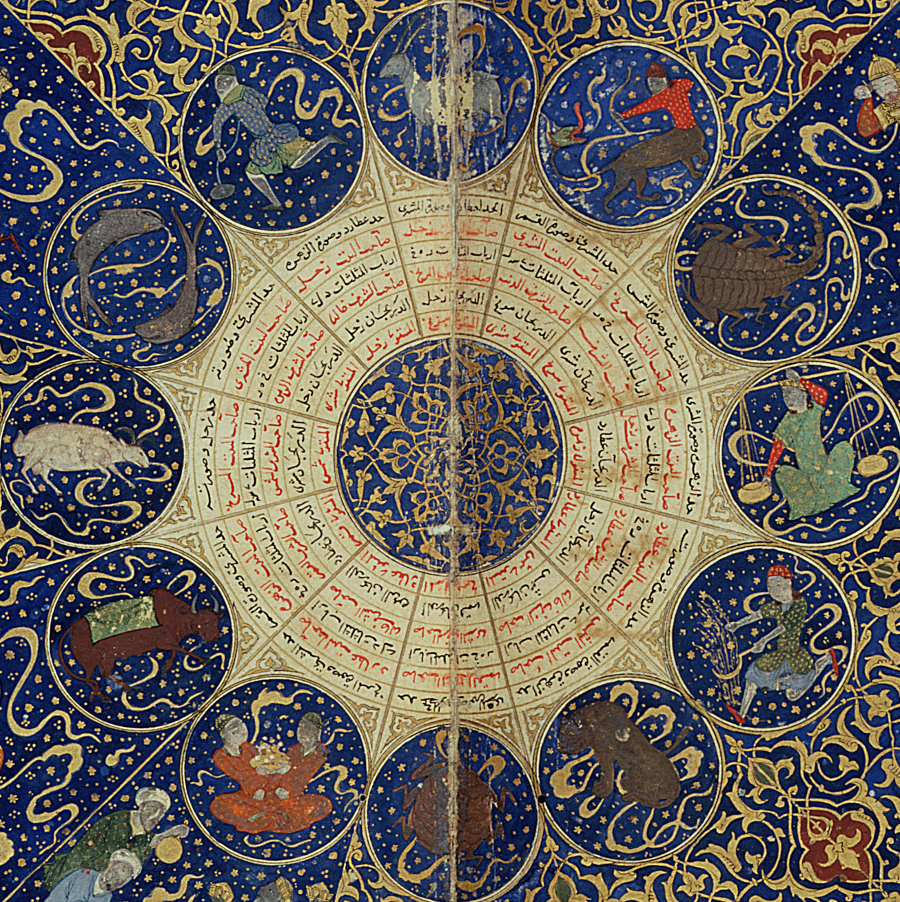

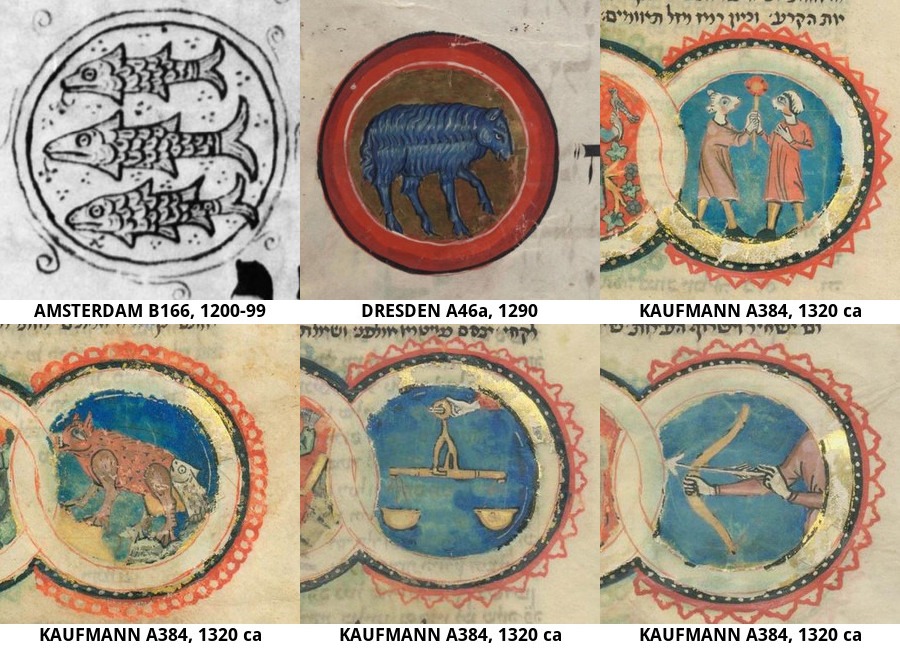
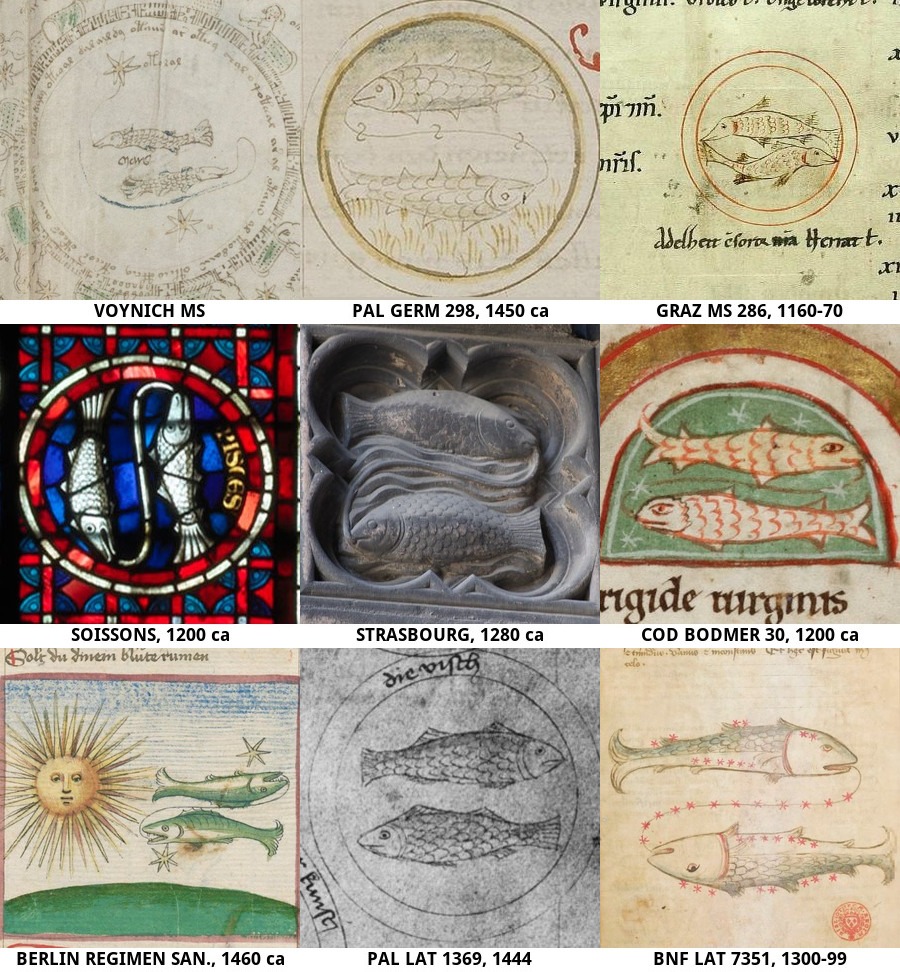
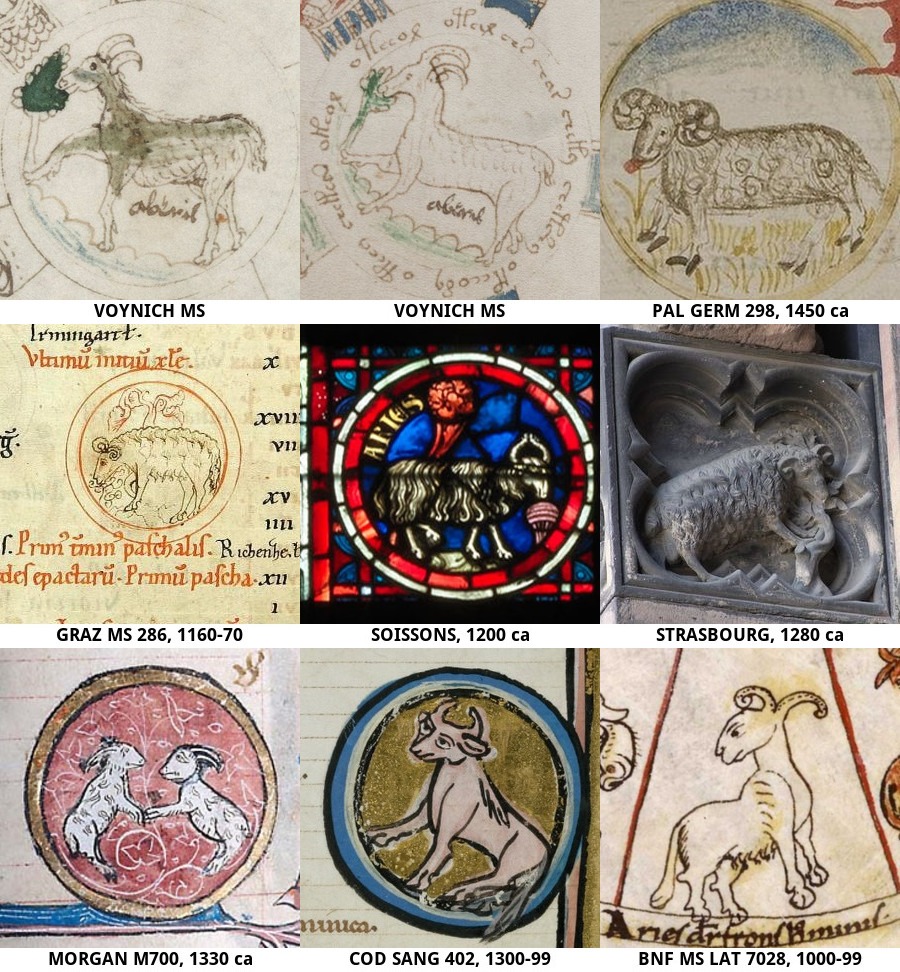
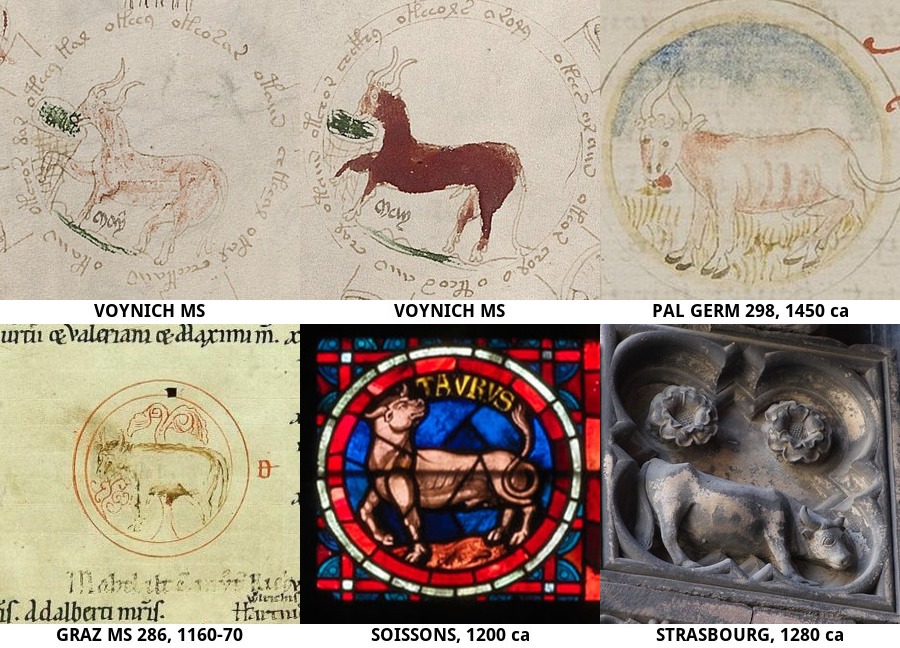
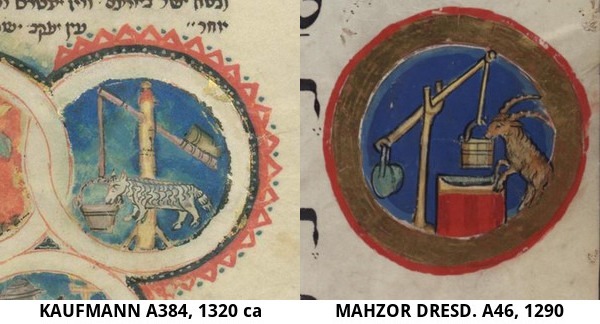
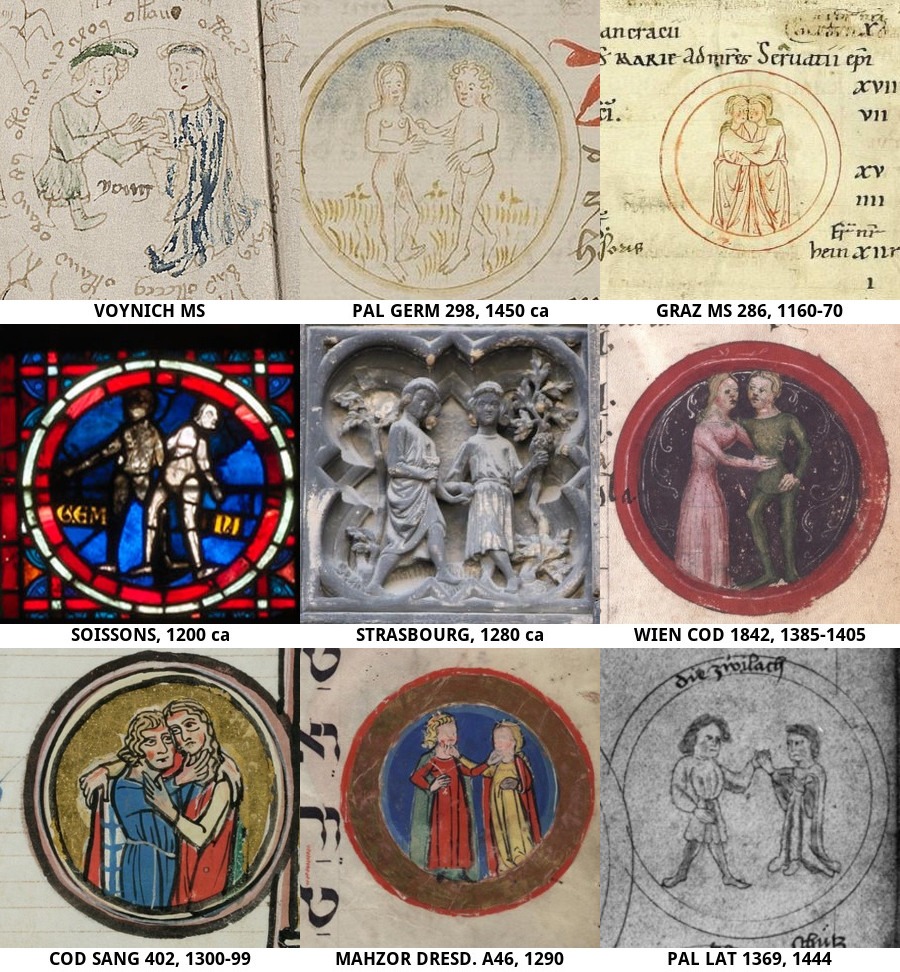
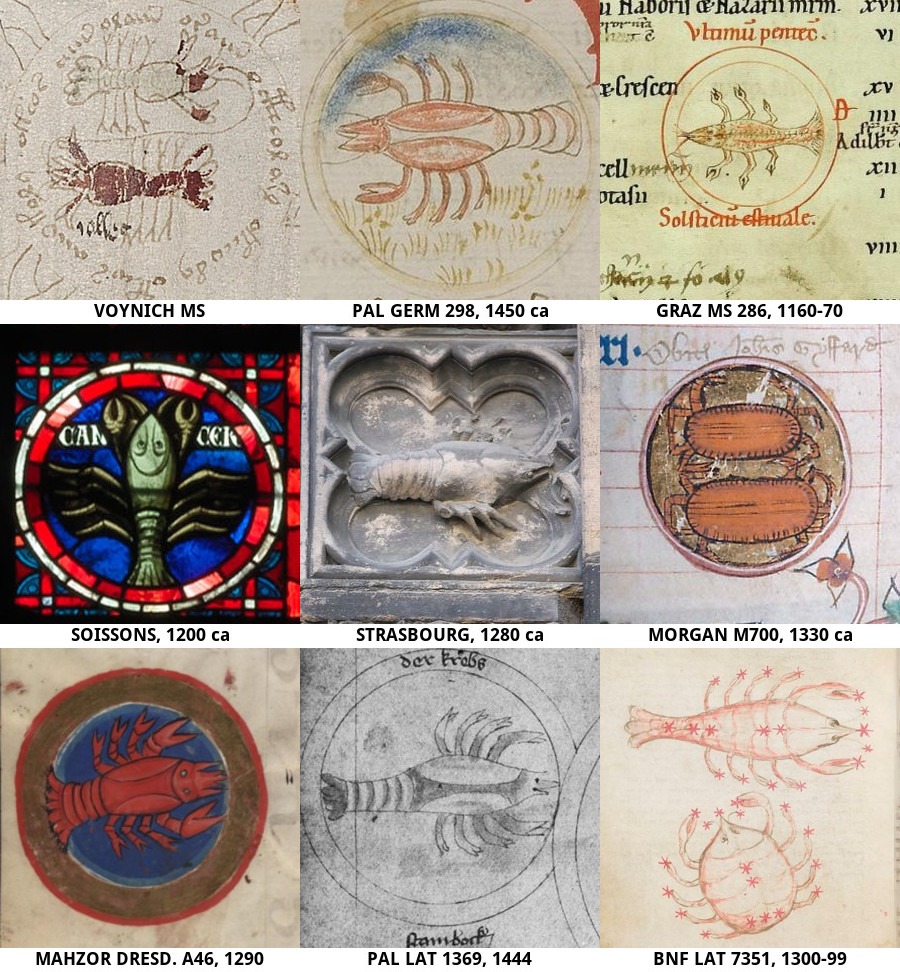
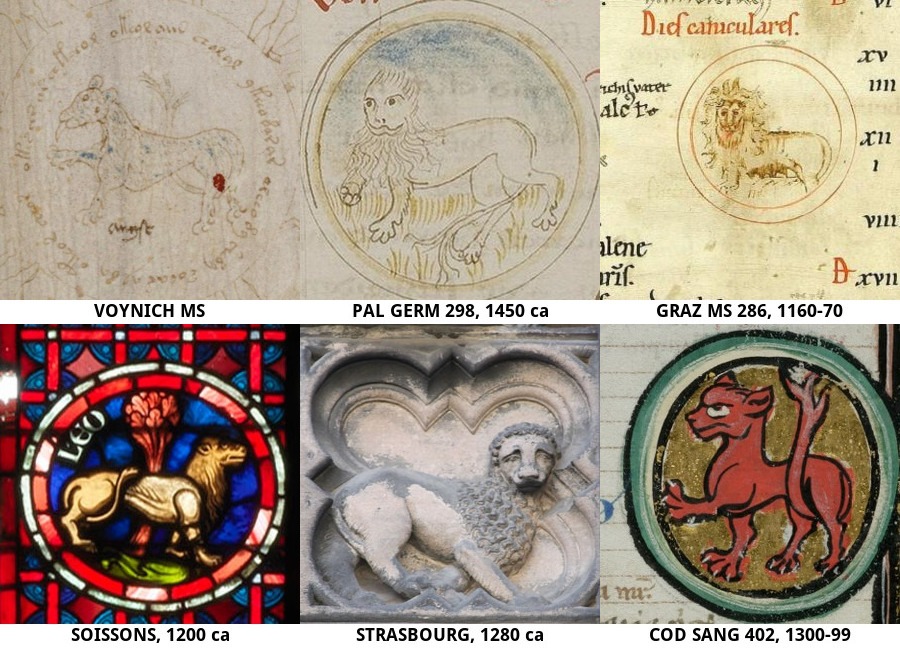

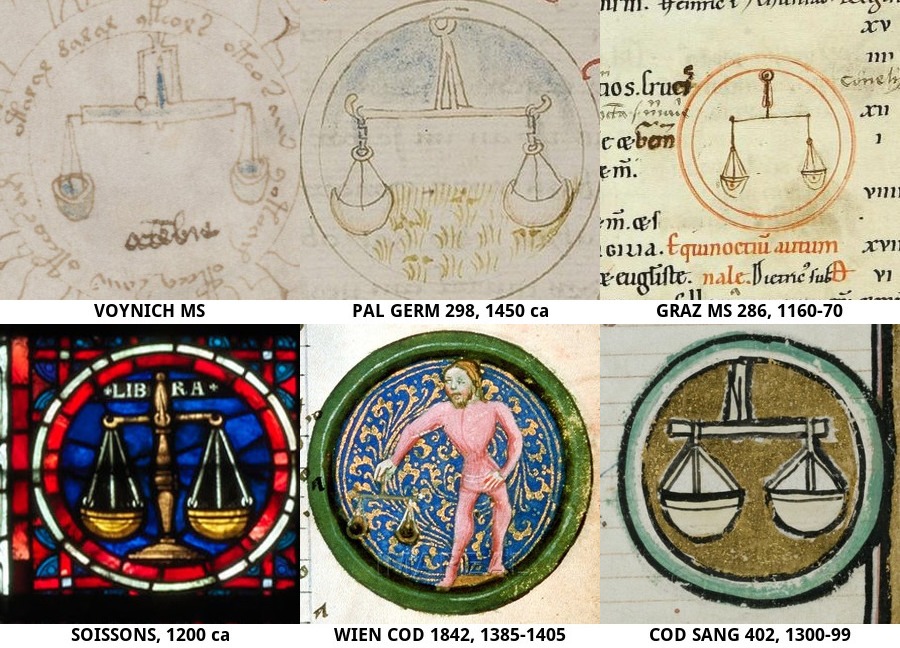
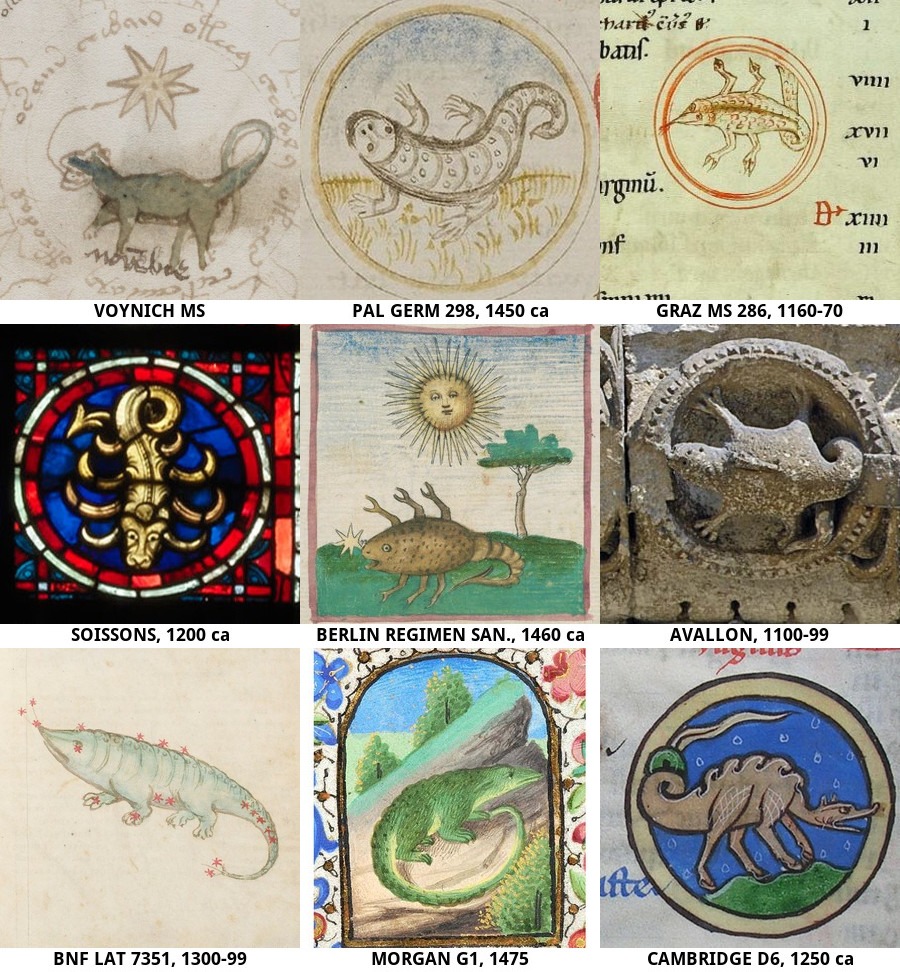
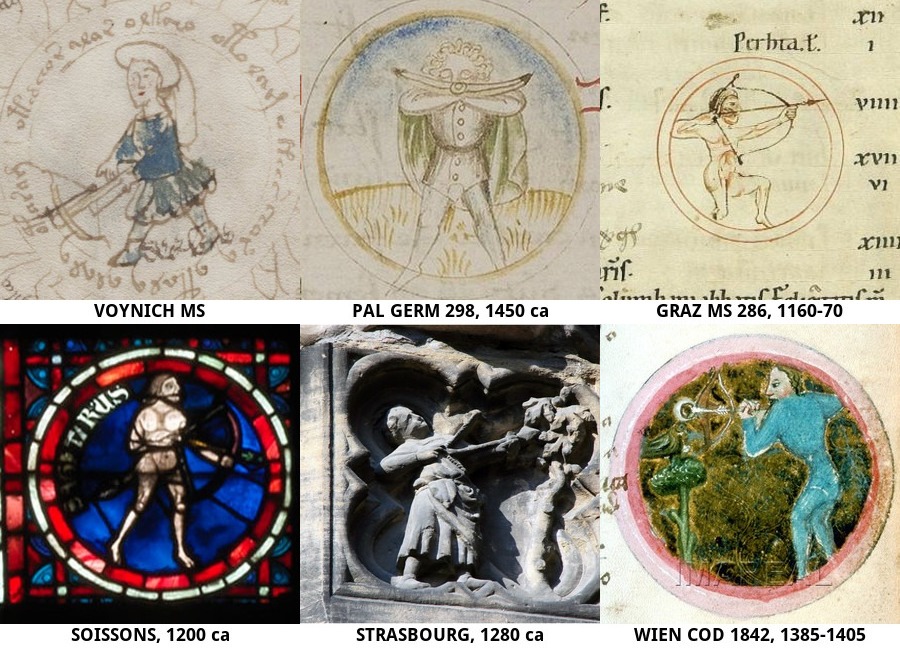
59 Comments
Trackbacks